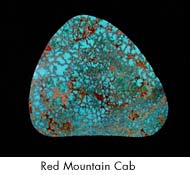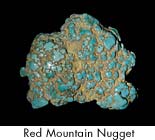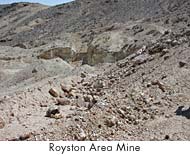 PILOT MOUNTAIN
PILOT MOUNTAIN
Pilot Mountain turquoise
is made up of a group of mines at the southern
end of the Pilot Mountains in Mineral County,
Nevada a short distance outside of Tonopah.
The two most well known mines being the Moqui-Aztec
or S. Simmons and the Montezuma or Troy Springs
mine. The Montezuma is still being worked two
or three times a year and produces a hard thin
veined turquoise with colors ranging from a
bright blue to dark blue, along with a dark
blue with a greenish cast. Light to dark brown
limonite mottled patterns are associated with
this material. William Miller of Tonopah discovered
the Montezuma in 1905.
 back to top
back to top
 PINTO VALLEY MINE
see CASTLE
DOME page
PINTO VALLEY MINE
see CASTLE
DOME page
 RED MOUNTAIN
RED MOUNTAIN
 The Red Mountain turquoise mine produces a very
fine turquoise. Known for both the high quantity
of small high-grade nuggets that it produced
and the beautiful dark blue spider web of its
best grades. Red Mountains top material is a
hard compact spider web and is equal to any
of the classic turquoise mines such as Number
Eight, Lone Mountain or Nevada Blue. Besides
a dark blue color with a dark matrix the mine
produces colors in the blue green range with
a stunning gold or rust-colored spider web.
The Red Mountain turquoise mine produces a very
fine turquoise. Known for both the high quantity
of small high-grade nuggets that it produced
and the beautiful dark blue spider web of its
best grades. Red Mountains top material is a
hard compact spider web and is equal to any
of the classic turquoise mines such as Number
Eight, Lone Mountain or Nevada Blue. Besides
a dark blue color with a dark matrix the mine
produces colors in the blue green range with
a stunning gold or rust-colored spider web.
 Located in Northern Nevada the mine was owned
for many years by Austin Turner. Turner did
little mining. Much of the turquoise had been
mined before Turner had taken over the claim.
From 1982 to 1985 Erman Blossom and his partner
leased the mine and removed a fair amount of
turquoise. Turner sold the mine in 2003 and
today the present owner works the mine a few
times a year where turquoise is still being
found in the mine’s old dump.
Located in Northern Nevada the mine was owned
for many years by Austin Turner. Turner did
little mining. Much of the turquoise had been
mined before Turner had taken over the claim.
From 1982 to 1985 Erman Blossom and his partner
leased the mine and removed a fair amount of
turquoise. Turner sold the mine in 2003 and
today the present owner works the mine a few
times a year where turquoise is still being
found in the mine’s old dump.
 back to top
back to top
 ROYSTON
ROYSTON
 The
Royston district is one of the better known
turquoise producing areas in Nevada. Royston
turquoise comes from a group of mines about
24 miles northwest of Tonopah. Although the
district is made up of a number of small mines
the three more important mines are the Royal
Blue, the Bunker Hill, and the Oscar Wehrend.
Royston turquoise can be unbelievably beautiful.
High-grade Royston is a very hard material.
Colors range from a light blue, intense blue
or a dark sky blue. Also included are a number
of shades of green and many times with green
and blue together in one stone. The matrix includes
different shades of brown. The best Royston
is equal to that found in any American mine. The
Royston district is one of the better known
turquoise producing areas in Nevada. Royston
turquoise comes from a group of mines about
24 miles northwest of Tonopah. Although the
district is made up of a number of small mines
the three more important mines are the Royal
Blue, the Bunker Hill, and the Oscar Wehrend.
Royston turquoise can be unbelievably beautiful.
High-grade Royston is a very hard material.
Colors range from a light blue, intense blue
or a dark sky blue. Also included are a number
of shades of green and many times with green
and blue together in one stone. The matrix includes
different shades of brown. The best Royston
is equal to that found in any American mine.
 The
Royal Blue mine constituted the main workings
in the area. The blue colors from this mine
were beautiful and equal to any and the matrix
was especially fine. In 1968 high-grade cut
stones retailed at $1.00 a carat, which in today
market would be the equivalent to over $20.00
a carat. The mine was discovered in 1902 by
two miners named Workman and Davis, they later
sold the mine for $3000. Over the years as with
other mines the Royal Blue changed hands numerous
times. The Bunker Hill mine was discovered in
1927 by Roy Palfreyman and Bert Kopenhaver.
The Oscar Wehrend mine was discovered in 1909,
production from this mine was low and not of
the quality of the other two. Today the Royston
district is still producing turquoise of high
quality, but in limited amounts. The
Royal Blue mine constituted the main workings
in the area. The blue colors from this mine
were beautiful and equal to any and the matrix
was especially fine. In 1968 high-grade cut
stones retailed at $1.00 a carat, which in today
market would be the equivalent to over $20.00
a carat. The mine was discovered in 1902 by
two miners named Workman and Davis, they later
sold the mine for $3000. Over the years as with
other mines the Royal Blue changed hands numerous
times. The Bunker Hill mine was discovered in
1927 by Roy Palfreyman and Bert Kopenhaver.
The Oscar Wehrend mine was discovered in 1909,
production from this mine was low and not of
the quality of the other two. Today the Royston
district is still producing turquoise of high
quality, but in limited amounts.
|